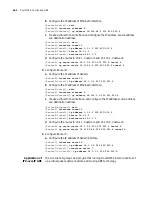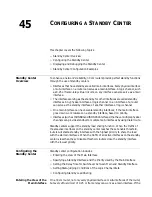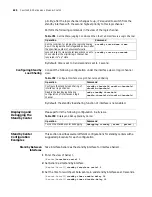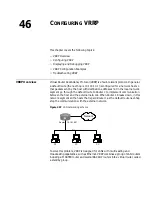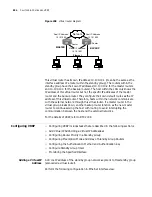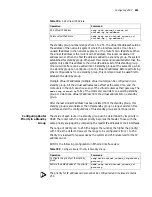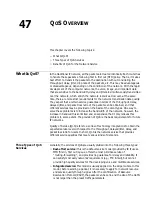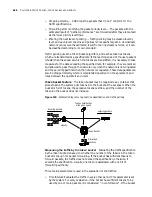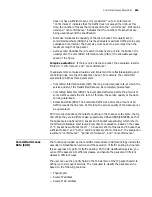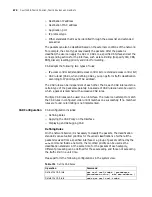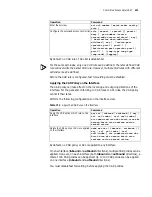
656
C
HAPTER
46: C
ONFIGURING
VRRP
Configuring Preemption
Mode and Delay of
Standby Group Routers
Once a router in the standby group becomes the master router, so long as it still
functions properly, other routers, even configured with higher priority later, cannot
become the master router unless they are configured with preemption mode. The
router in preemption mode becomes the master router if it finds its own priority is
higher than that of the present master router. Accordingly, the former master
router becomes the backup router.
Along with preemption mode, delay can also be configured. This delays the
coming of the point when the backup router becomes the master router. The
purpose for this is: in an unstable network if the backup router has not received
the packets from the master router punctually, it will become the master router
(failure of backup to receive the packets may be due to network congestion, not
due to malfunction of the master router). Therefore, a delay insures the reception
of the packet from the master router and thus avoids frequent state switches.
The default mode is preemption without delay. The delay is set in seconds, ranging
from 1 to 255.
Perform the following configuration in Ethernet interface view:
Table 706
Configure Preemption Mode and Delay of Standby Group Routers
Configuring the
Authentication Method
and Authentication Key
VRRP provides simple character authentication method.
In a secure network, authentication can be configured to No, which means no
authentication will be conducted by the router to the VRRP packets being sent
out. And the router receiving the VRRP packets will take them as true and legal
without any authentication. In this case no authentication key is needed.
In a network under possible security threat, the authentication method can be
configured to
simple
. That means the router sending out the VRRP packets fills
the authentication key into the VRRP packets, while the router receiving the VRRP
packet will compare the authentication key of the packet with the locally
configured authentication key. If they are the same, the packet will be taken as a
true and legal one. Otherwise, it will be regarded as an illegal packet to be
discarded. In this case, an authentication key of less than 8 bits will be configured.
Perform the following configuration in Ethernet interface view:
Table 707
Configure Authentication Method and Authentication Key
The same authentication method and authentication key should be configured for
the standby group of an interface.
Operation
Command
Configure the preemption mode and
delay for standby group.
vrrp vrid
virtual_router_id
preempt-mode [ timer-delay
seconds
]
Delete preemption mode
undo vrrp vrid
virtual_router_id
preempt-mode
Operation
Command
Configure authentication method and
authentication key
vrrp authentication-mode simple [
key
]
Disabled VRRP authentication
undo vrrp authentication-mode simple
Summary of Contents for Router 3032
Page 1: ...http www 3com com 3Com Router Configuration Guide Published March 2004 Part No 10014299...
Page 4: ...VPN 615 RELIABILITY 665 QOS 681 DIAL UP 721...
Page 6: ...2 ABOUT THIS GUIDE...
Page 7: ...I GETTING STARTED Chapter 1 3Com Router Introduction Chapter 2 3Com Router User Interface...
Page 8: ...4...
Page 16: ...12 CHAPTER 1 3COM ROUTER INTRODUCTION...
Page 34: ...30...
Page 60: ...56 CHAPTER 3 SYSTEM MANAGEMENT...
Page 98: ...94 CHAPTER 6 DISPLAY AND DEBUGGING TOOLS...
Page 110: ...106...
Page 114: ...110 CHAPTER 8 INTERFACE CONFIGURATION OVERVIEW...
Page 158: ...154 CHAPTER 10 CONFIGURING WAN INTERFACE...
Page 168: ...164...
Page 188: ...184 CHAPTER 13 CONFIGURING PPPOE CLIENT...
Page 192: ...188 CHAPTER 14 CONFIGURING SLIP Router ip route static 0 0 0 0 0 0 0 0 10 110 0 1...
Page 248: ...244 CHAPTER 16 CONFIGURING LAPB AND X 25...
Page 320: ...316...
Page 330: ...326 CHAPTER 20 CONFIGURING IP ADDRESS...
Page 362: ...358 CHAPTER 21 CONFIGURING IP APPLICATION...
Page 374: ...370 CHAPTER 23 CONFIGURING IP COUNT...
Page 406: ...402 CHAPTER 25 CONFIGURING DLSW...
Page 408: ...404...
Page 452: ...448 CHAPTER 29 CONFIGURING OSPF...
Page 482: ...478 CHAPTER 30 CONFIGURING BGP...
Page 494: ...490 CHAPTER 31 CONFIGURING IP ROUTING POLICY...
Page 502: ...498...
Page 508: ...504 CHAPTER 33 IP MULTICAST...
Page 514: ...510 CHAPTER 34 CONFIGURING IGMP...
Page 526: ...522 CHAPTER 36 CONFIGURING PIM SM...
Page 528: ...524...
Page 532: ...528 CHAPTER 37 CONFIGURING TERMINAL ACCESS SECURITY...
Page 550: ...546 CHAPTER 38 CONFIGURING AAA AND RADIUS PROTOCOL...
Page 590: ...586 CHAPTER 40 CONFIGURING IPSEC...
Page 599: ...IX VPN Chapter 42 Configuring VPN Chapter 43 Configuring L2TP Chapter 44 Configuring GRE...
Page 600: ...596...
Page 638: ...634 CHAPTER 43 CONFIGURING L2TP...
Page 649: ...X RELIABILITY Chapter 45 Configuring a Standby Center Chapter 46 Configuring VRRP...
Page 650: ...646...
Page 666: ...662...
Page 670: ...666 CHAPTER 47 QOS OVERVIEW...
Page 700: ...696 CHAPTER 49 CONGESTION MANAGEMENT...
Page 706: ...702 CHAPTER 50 CONGESTION AVOIDANCE...
Page 707: ...XII DIAL UP Chapter 51 Configuring DCC Chapter 52 Configuring Modem...
Page 708: ...704...
Page 762: ...758 CHAPTER 52 CONFIGURING MODEM...

